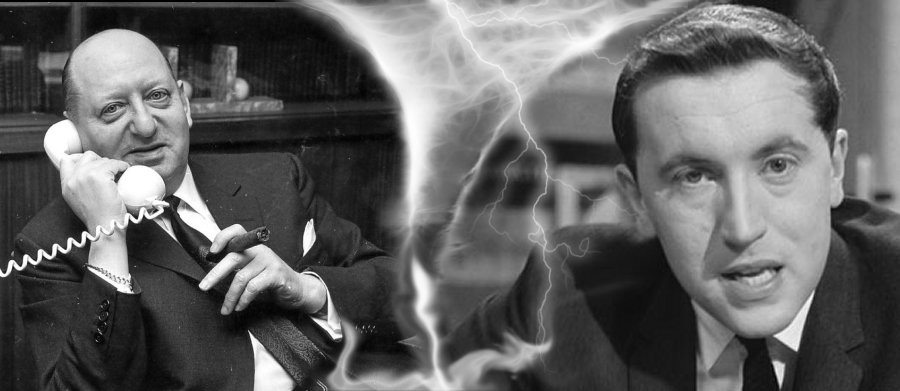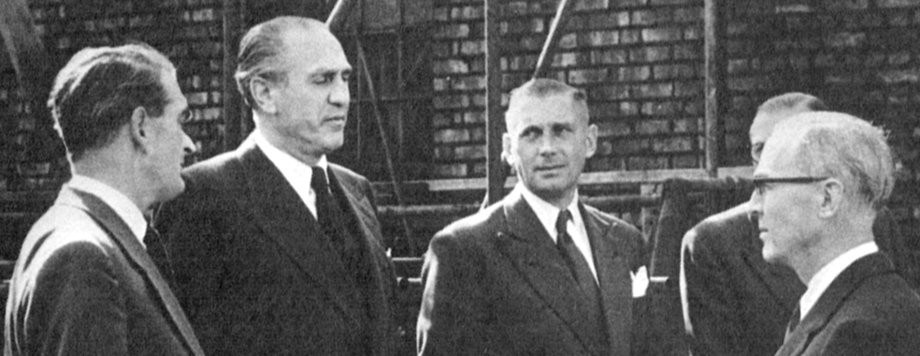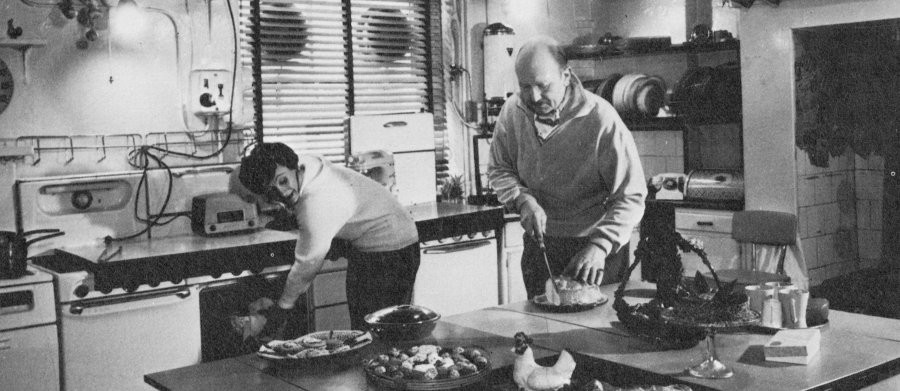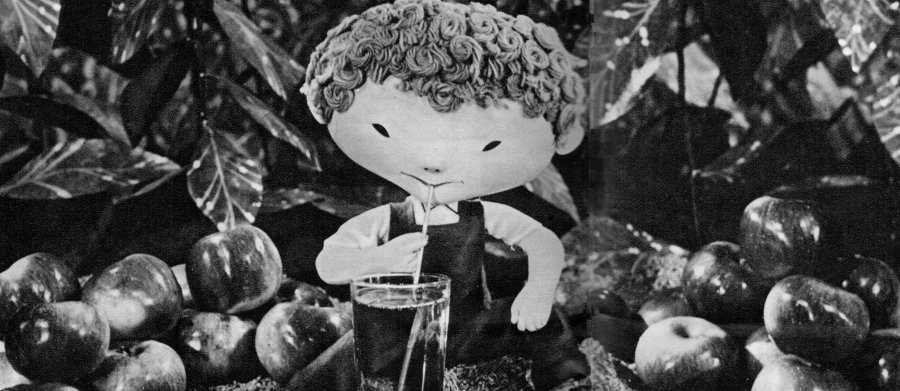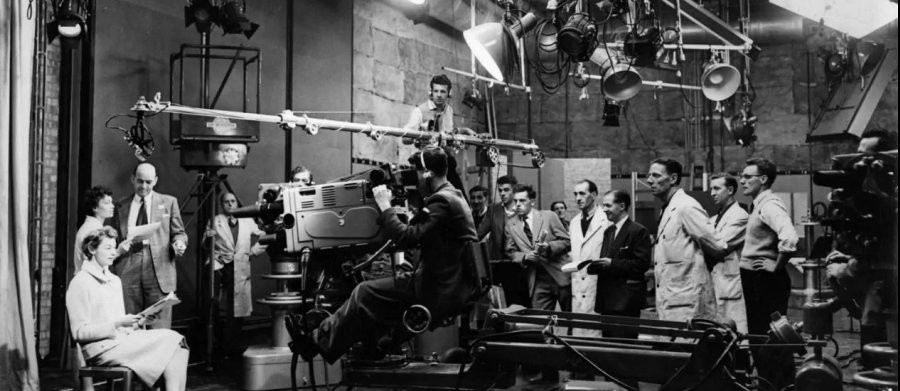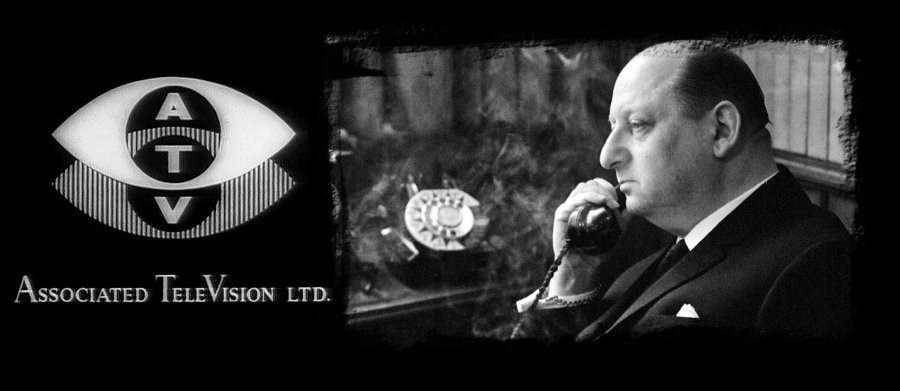
The History of ITV - Anglia Presents
Before the newly formed company had even found offices to operate out of the ITA franchise for the East of England was granted to them.
In Britain, at the beginning of 1958 ITV was still expanding throughout the country. Following the Television Act of 1954 which had empowered the ITA to set up television services additional to those provided by the BBC, ITV had begun broadcasting in September 1955. Independent Television started in London and soon spread to the Midlands and the North of England in 1956 and central Scotland by 1957, establishing itself, wherever broadcast, as the choice of the majority of the viewing public. The first four companies provided the bulk of programmes nationally but were also expected to make regional programmes and were therefore known as central or networking companies. Another ten companies were to make programmes primarily for their own regions, though they could seek to contribute to the network.
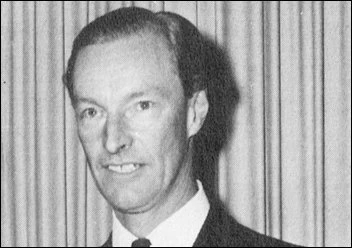
When applications were invited for the franchise to serve the East of England, which was to be ITV's first truly rural region, Lord Townshend, a leading Norfolk farmer, brought together a group including The Guardian newspaper and Romulus Films, a company founded by Sir John Woolf and James Woolf at the start of the 1950s, whose first commercial success had been The African Queen (1951) starring Humphrey Bogart and Katherine Hepburn. Other members of the board of Anglia Television included people who were strongly rooted in the area but also had diverse interests. Sir Robert Bignold was an eminent Norfolk industrialist, chairman of Norwich Union and a former Lord Mayor of Norwich. Aubrey Buxton was a conservationist who had served with the Army with distinction during the Second World War and was awarded the Military Cross in 1944. Sir Peter Greenwell was a Suffolk farmer who raised prize cattle. William Copeman headed the Eastern Daily Press and other East Anglian publications, and Laurence Scott was chairman of The Guardian as well as chairman of the Press Association. The other board members were Sir John Woolf, Sir Donald Albery, head of a London theatre group and two Cambridge academics; Professor Glyn Daniel (archaeologist) and Dr Audrey Richards (anthropologist).
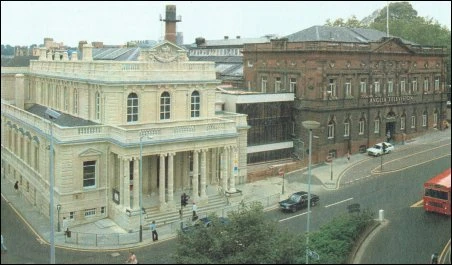
Before the newly formed company had even found offices to operate out of the ITA franchise for the East of England was granted to them. Anglia quickly found a home in the centre of Norwich in a building that had been known for three-quarters of a century as the Agricultural Hall. Anglia acquired The Hall on a 75-year lease and quickly set about adapting it. An assembly hall at the front of the building was divided into offices while the main exhibition hall, formerly used for cattle shows, circuses and banquets was converted into studios. In order to make these studios soundproof it was necessary to erect a new building within the old one with a reinforced concrete frame. The building was renamed Anglia House. At the same time, 30 miles away in Suffolk work was underway to erect a 1,000-foot transmitter. The mast at Mendlesham was the tallest in Europe, weighed 180 tons and was supported by 15 steel cables. It took workmen an hour to climb the 1,257 rungs to the top.
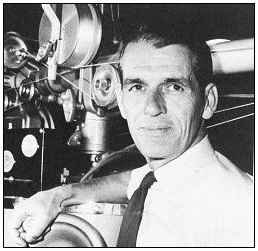
The company was now ready to take on its first employee and to start advertising for staff. Tom Marshall was hired as Chief Engineer. It was his job to supervise the equipping of the studios and other technical areas. 300 employees followed - executives, technicians, entertainers, journalists, and secretaries. The company put out an advertisement for newscasters and were swamped with more than a thousand applications. These were 'paper-sifted' down to seventy likely candidates who were then invited for an audition in which they had to read an announcement about a circus in which all the artistes had foreign names and then interview an executive, posing as a yachtsman whose wife and three children had drowned in a sailing tragedy. At the end, three candidates were hired.
The first issue of an Anglia edition of the TV Times was produced announcing the imminent opening of the new station. In it, Lord Townshend wrote: 'We are a regional station in the true sense of the word. This will ensure that we shall produce local news and programmes with local insight and provide a platform for local talent and material. This is not enough in itself, however, because television is a medium of national importance and we need the best brains and experience in the entertainment world. We have the good fortune to have leaders from the film world and the theatre. Their reputation is such that our plays will be networked throughout the country.'
"Anglia Television is on the air..."

The first day of transmission for Anglia Television was on Tuesday October 27, 1959. Broadcasting began at 4.15pm with a picture of the Mendlesham mast and a voiceover announcing, "Anglia Television is on the air." The first programme, Introducing Anglia, took viewers on a tour of the region with aerial views of the countryside. The thirty-minute programme also took viewers on a tour of the company's studios and they were shown previews of Anglia produced programmes to come. This was followed by children's programmes and at 6.5 Newman Sanders presented Anglia's first news programme. A fifteen-minute documentary, Birth of a Regiment, was shown at 6.45 and later, at 9.45pm an Anglia production reached the whole country for the first time with its first drama for the network, The Violent Years, starring Laurence Harvey and Hildegarde Neff, which went out under the Play of the Week banner. The station closed for the evening at 11.10pm.
The following day brought the first edition of Anglia's chief regional show, The Midday Show, which, despite its title went out at 1.02pm. The format was not unlike other regional shows across the ITV network and included interviews with local characters, items on records, book and film reviews and items on gardening, pets, shopping and motoring. Philip Bray presented many of the items and he was also the programme's producer. Musical items were provided by singers Roger Gage and Susan Hampshire-who later became an internationally known actress.
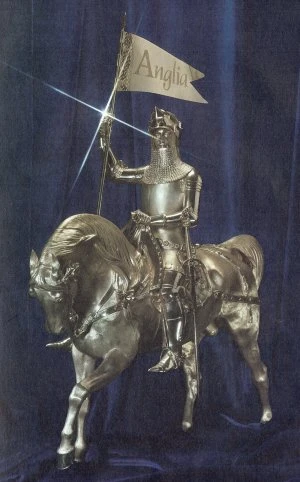
Originally, the directors had thought of using Britannia as the company logo. But whilst walking along Bond Street, in London, Lord Townshend saw the figure in Asprey, once the destination for crowns, coronets and sceptres for royal families around the world. It had originally been modelled on a statue of Richard the Lionheart that stands outside the Houses of Parliament and was commissioned from a London firm of silversmiths by the King of the Netherlands in 1850 as a sporting trophy. It was later won by an Englishman who brought it home where it had remained in the possession of his family. After Anglia acquired it they got Asprey to make some modifications including the 'Anglia' pennon on the lance.
By 1961, Anglia's 'local' audience of 213,000 homes, mainly in Norfolk, Suffolk, Cambridgeshire, and Essex grew to 423,000 as it reached Bedfordshire and Lincolnshire. The opening of a new transmitter in 1965 also made the station accessible to viewers in Hertfordshire, Northamptonshire and much further afield. By December of that year about a million homes could receive Anglia television.

About Anglia first broadcast in May 1960, soon became the flagship television news magazine for Anglia Television. Its original presenter was Dick Joice. The programme brought together the early evening regional news and magazine articles from The Midday Show. Initially it was shown twice weekly but in September it was extended to four evenings a week and then five. David Frost began his television career in this programme when he was employed for several months in 1960 as a reporter. His first recorded interview was with two Cambridge councillors. However, his contract was not renewed as Anglia's executives didn't think he had a future in regional television. One feature of every programme was the weather forecast and Anglia became the first regional ITV company to set up its own weather service under a professional meteorologist. Another long-running feature which first appeared in January 1963 was Police Call, compiled in collaboration with the police; its aim was to ask the public to give vital information in unsolved crimes. Dick Joice was the first presenter but in 1977 it was decided to invite the police to front it themselves. Another project, unique in regional television, entitled Round Robin Child and run with the assistance and co-operation of welfare authorities and adoption agencies, sought to find homes for children who are normally the most difficult to place, such as those with physical, mental disabilities.
Survival became the first British programme to be sold to China, the first to be broadcast across the continent of North America and its team were the first to shoot a major wildlife series in the Soviet Union.
Of all Anglia's television programmes the most celebrated is, without doubt, Survival. The programme sprang from a 15-minute natural history programme called Countryman which Aubrey Buxton, a dedicated naturalist with a particular interest in ornithology, had started in June 1960 and presented on screen himself. At that time Granada Television began to wind down its unit based at the London Zoo which made animal programmes, such as Zoo Time, for the network. Buxton saw an opportunity to offer ITV a new wildlife series. As a pilot for the series he made a programme about the Copyu, a rodent from South America that caused much destruction in the region. Associated-Rediffusion, then the London weekday broadcaster, agreed to back Survival provided the first programme was about wildlife in Central London. Colin Willock, then deputy editor of the current affairs series This Week worked on the show. The second programme was filmed in East Anglia but with the third edition Wilcock and a cameraman travelled to Uganda to do an edition on the almost extinct white rhino. From that show on Survival travelled the world producing six half-hour programmes a year. The basic theme of each production was the conflict between man and nature with the programme coming down firmly on the side of conservation.
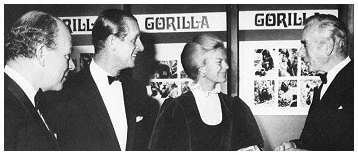
As he was launching Survival, Aubrey Buxton also helped to found the World Wildlife Fund along with Peter Scott and others, including David Attenborough. "When we founded WWF nobody knew what conservation meant," Buxton recalled. "But today everybody at every bus stop, in every school, in every street, is aware of it." Prince Phillip became chairman of the British appeal of the WWF introducing an hour-long special about conservation in Africa, The New Ark, which won Survival's first international award, the Golden Nymph of the Monte Carlo Film Festival in 1963. The original series ran for 40 years during which nearly 1000 shows were produced. It was also one of the UK's most lucrative television exports, with sales to 112 countries. In its prime, it achieved the highest overseas sales of any British documentary programme and, in 1974, gained a Queen's Award for export success. It became the first British programme sold to China (1979), the first to be broadcast simultaneously across the continent of North America (1987) and its camera teams were the first to shoot a major wildlife series in the former Soviet Union (1989-91). Survival films and filmmakers won more than 250 awards worldwide, including four Emmy Awards and a BAFTA. Buxton, producer of Survival for most of its life, also received a Royal Television Society silver medal in 1968 for outstanding artistic achievement, and a gold medal in 1977.
Anglia also has a great pedigree in producing drama programmes. Its first play, on opening night, The Violent Years, concerned a man on trial for his life in an American court, reflecting on his past in Australia and Germany while awaiting the jury's verdict. Sweet Poison in December 1959 starred Dawn Addams and John Ireland. Carrington VC, in January 1960 starred Richard Todd, Ann Todd and Dorothy Tutin. All three made the weekly Top Ten charts. A startling debut for a new company. But the production of these plays was not without difficulty. Initially, the top four television companies were of the opinion that they were producing enough drama for the entire network and were reluctant to reduce their output to let in the newcomer. However, Associated-Rediffusion eventually agreed to provide time for up to eight Anglia plays a year but with the provision that they be made in its Wembley studios and using its technicians. It was not long before Anglia's reputation as a quality drama producer grew sufficiently enough for it to move productions back to Norwich.
Billed as television's first rural soap, Weavers Green launched in 1966 and was set in an imaginary East Anglian village of that name. It featured a fictional veterinary practice run by the Armstrong family. Created by Betty Paul, Weavers Green was Anglia's answer to The Archers. This was a new venture for a regional company and was also pioneering in as much as it was the first production to be filmed on location in the region with a mobile video unit. However, Anglia was unable to obtain the two networked weekday slots the series required. One episode was shown on Thursday and the other on Saturday or Sunday depending on the region. "It didn't work," Betty admitted. "We'd have liked the programme to be shown either during the week or at weekends, but not a mixture of both. Back then, it was a different audience who watched television at weekends." Also disappointed was Weavers Green's glamorous star, Kate O'Mara, who played the young vet "Mick" Armstrong. "It was successful," she recalled, "but the network refused to give it a regular slot, so people couldn't get into it." Betty learned that the show was to be dropped, after 49 episodes, when she read the news in the paper.
In 1977 Anglia produced its first situation comedy, Backs to the Land. This is a story of three girls who give up the city life to work on a farm in the Women's Land Army during the Second World War. Like Weavers Green, the series made extensive use of the region's countryside with location filming taking place in a Norfolk village and its local pub, church and community hall. This was followed by the £1.5million production Tales of the Unexpected, based on the best-selling stories of Roald Dahl. Another hit series for Anglia was the quiz show Sale of the Century, hosted by Nicholas Parsons.
More than a million viewers were lost...
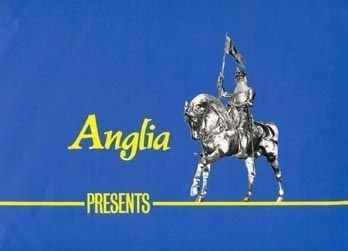
In 1974 the IBA (formerly the ITA) redefined the region for Anglia Television. Where Anglia and Yorkshire overlapped around Humberside both services were available. The IBA decided that the Belmont transmitter in Lincolnshire would be given over to the Yorkshire area, bringing the northern boundary of Anglia back to its 1965 position. Despite a storm of protests from viewers the decision was stuck to and more than a million viewers in Humberside, Lincolnshire and parts of Norfolk were lost. Today Anglia broadcasts to Norfolk, Suffolk, Cambridgeshire, North Essex, southern Lincolnshire, Northamptonshire, a small part of southern Leicestershire, Bedfordshire, northern Buckinghamshire, and northern Hertfordshire. In 1988 the knight ident was replaced by a quasi-heraldic stylised 'A' made of triangles, which faded in and out on a fluttering flag. In the early 1990s, this was replaced with a black background and the flag fading in slowly to deep sombre music with a lighter end to it. This was used until 1999.
During the broadcasting franchise reviews and applications of the 1980s Anglia managed to hold off opposition from only one other applicant, but in 1992 they faced stronger opposition from two consortia: Three East and CPV-TV. Anglia bid nearly £3 million more than Three East, which had crossed the quality threshold (CPV-TV had not), and they retained their broadcasting licence. In 1993, the station took over the cartoon studio Cosgrove Hall, when it was sold off by its original owners, Thames Television. Then in early 1994, Anglia was bought by MAI (owners of Meridian Broadcasting), who merged with United Newspapers to form United News and Media. They were joined by HTV in 1996. In 2000, following United's aborted merger attempt with Carlton, Granada bought the TV assets of United (but sold the broadcasting arm of HTV). In 2004, Granada finally merged with Carlton to form ITV plc, which ended Anglia's existence as a separate brand.
Much of Anglia TV's back catalogue is now held and preserved at the East Anglian Film Archive. A number of Anglia's Television productions including The Way We Were, Bygones and Anglia at War have been released on DVD. A compilation of the first years of Anglia TV's local news, Here Was the News was also released in 2009.
Published on November 4th, 2020. Written by Laurence Marcus - Sources: Anglia Television...the first twenty-one years published in 1980 by Anglia Television Group Ltd. With additional Internet sources. for Television Heaven.


